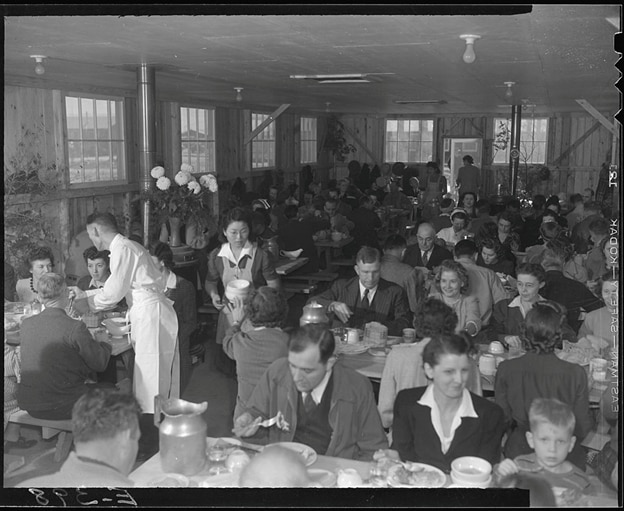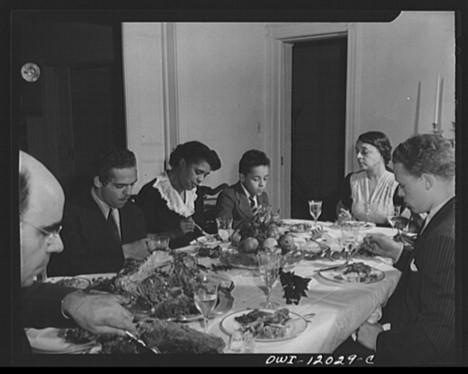The world’s largest online family history resource - Start now
-
Black History Month – Ancestry Initiatives to Honor Black Heritage -
Marking 80 Years Since Auschwitz Liberation: Our Commitment to Holocaust Remembrance -
1921 Census of England & Wales Now Available -
Updated Ancestral Subregions
GET THE LATEST
New posts + monthly newsletter.
GET THE LATEST
New posts + monthly newsletter.
When you think of family Thanksgiving celebrations, what comes to mind? For many people, it’s the food. It could be the scents of Grandma’s signature turkey commingling with the warm, spicy apple cider, and pumpkin pie amidst laughing family members.
Memories are often inundated with scents and tastes. Flavors themselves are highly influenced by the sense of smell—and the brain structures related to the sense of smell can trigger the most important parts of the brain for emotion and memory.
Given the closeness between making and evoking cherished memories and foods, it’s no wonder so many people celebrate their holiday traditions with traditional dishes. Those family recipes are the key to creating powerful memories, helping you feel closer to the loved ones who passed them on to you.
Thanksgiving recipes are often flavorful and aromatic, spurring grand memories of family gatherings. This Thanksgiving, you can connect with your loved ones through sharing and learning family recipes.
Collect Family Recipes
Family recipes are often passed down, with each generation learning them as they grow up. They serve as a bridge to your family’s past, connecting you to the labors of love your relatives performed. When you learn how they prepare their recipes, you’re discovering and preserving a dish that may be decades, or even centuries, old.
This Thanksgiving, get involved in the prep work. Carefully study and interview your relatives to learn more about their processes and preferred ingredients, and craft a heritage cookbook of family recipes.
Traditional Thanksgiving Recipes

The classic Thanksgiving dinner can look different from region to region, but there are some key components found throughout the United States. The meal usually consists of a roast turkey and gravy, stuffing, mashed potatoes, various roasted vegetables, dinner rolls, and an apple or pumpkin pie for dessert. Some families may opt for a ham or prime rib roast in lieu of a turkey, while others may bring in sides such as green bean casserole, macaroni and cheese, and all sorts of appetizers.
At first glance, iconic Thanksgiving dishes like turkey, stuffing, and cranberry sauce might seem like nothing more than tasty meals to enjoy with loved ones. However, they’re more than that. Deeply ingrained in the fabric of tradition and history, they can tell stories of cultural unions, adaptation, and celebration. Consider the history behind these Thanksgiving staples:
- Roast turkey: The centerpiece of most Thanksgiving dinners has a fascinating journey. Wild turkeys are native to North America and were already a significant source of food for Native Americans. When the Pilgrims arrived in the 17th century, they were generally familiar with consuming turkeys brought to Europe by the Spanish. It wasn’t until the 19th century when the turkey’s association with Thanksgiving began to take root. As Sarah Josepha Hale, often referred to as the “Mother of Thanksgiving,” campaigned to make Thanksgiving a national holiday, her writings mentioned turkey as a major component of Thanksgiving meals. In turn, this helped popularize the bird as a staple of Thanksgiving feasts.
- Stuffing: With recipes and components varying from region to region, stuffing is as diverse as the United States itself. The overall evolution of stuffing is closely related to local ingredients and cultural influences. For example, cornbread is popular in the southern states and reflects the region’s cultural influences. Because recipes are directly influenced by cultural and regional elements, your family’s stuffing recipe can be a tasty window into your heritage.
- Cranberry sauce: Only a few fruits are native to North America, and cranberries are one of them. In fact, Native Americans used cranberries as a source of food, medicine, and as a dye. It was also Native Americans who introduced the Pilgrims to this fruit, but it didn’t become a Thanksgiving staple until sugar became more widely available during the 18th century. However, cranberry sauce as we know it today only appeared in the early 20th century with commercially canned sauces.
If you’re interested in your family’s history, consider reflecting on just how traditional recipes might have appeared on an ancestor’s table.
Connect Ancestral Research to Family Recipes
If you’re looking through the family cookbook to understand your heritage, there’s a good chance you can find all sorts of information. Various ingredients and techniques can point you in the right direction, especially if there are heritage dishes mixed into the collection.
You may be able to glean identifying information about the life your ancestors led. For example, Depression-era ingredients—those that could be foraged or afforded—such as wild berries or Spam and Kraft macaroni and cheese—could imply that your relatives were heavily impacted by the state of the economy. Ingredients associated with a certain cuisine, such as fish sauce and its prevalent use in Southeast Asian cuisine, could point you in the direction of your ancestral roots and where your family came from.
This Thanksgiving, while selecting your menu, don’t forget to browse through your family’s recipes and explore your family history. It’s a season for celebration and gratitude, so it’s the perfect time to pay your respects to your distant relatives.
Thanksgiving Desserts
Dessert is a staple of Thanksgiving dinners. While the classics are pumpkin and apple pies, there’s no limit to the creativity brought to the table. Some people opt to modify recipes, such as making their pumpkin pie in a sheet pan. Others let their innovation shine with turkey cupcakes or pecan pie brownies. If there’s a beloved family dessert recipe, you can also bring that to Thanksgiving dinner and let the positive associations bring your family closer together.
What Unique Twists on Tradition Can Teach You
Thanksgiving dinner is what your family makes of it, and there are no rules for your traditions. If your family reunions tend to include twists on traditional recipes or even completely unique ones, there is usually a story behind that.
- Family-specific recipes: Most families have their own takes on Thanksgiving recipes that are usually passed down through generations. Whether it’s a special method of preparing a turkey or a unique desert, they’re often accompanied by stories or anecdotes about the ancestors who created them. In these cases, recreating the recipes is more than just cooking; it’s bringing family history to life and keeping an ancestor’s legacy alive.
- Cultural fusions: The diversity of the United States can often be reflected in the variety of Thanksgiving dishes. What your family tends to incorporate into its Thanksgiving recipes can provide insight into your heritage. For example, families with Italian American roots may include pasta dishes in their Thanksgiving meals. Cultural fusion, especially in cuisine, can create compelling discussions around stories of immigration or assimilation concerning your ancestors.
- Regional specialties: If you’re celebrating Thanksgiving in Montana, you might not expect to find seafood sitting snuggly next to stuffing. However, that might be the case in New England where seafood is common. You can explore your family’s regional specialties to potentially learn more about where some ancestors may have lived and just how the local environment influenced their lives.
- Heirloom ingredients: In some cases, your family may use specific ingredients (or cooking techniques) that have been passed down through generations. Whether it’s growing a particular vegetable or using a specific cooking technique, these traditions can lead to interesting insights on an ancestor’s relationship with the land.
Just like searching for the meaning of your last name, uniqueness and specificity are great qualities for family history research. They tend to provide you with a more streamlined and focused set of information to dig into. As you enjoy your family’s Thanksgiving traditions this year, consider the opportunity to reflect on exactly how these traditions came to be.

Popular Holiday Recipes Around the World
While the US acknowledgment of Thanksgiving is specifically linked to a historic event, similar holidays are celebrated around the world. These holidays offer a chance for families to congregate and celebrate in each other’s company.
- Canada: In October, Canada recognizes its Thanksgiving, commemorating the safe arrival of Sir Martin Frobisher and his crew in the Eastern Arctic.
- Brazil: Each year, Brazil celebrates the unofficial holiday of Dia de Ação de Graças. The holiday began in the 1940s when a Brazilian ambassador in the United States saw Americans celebrating Thanksgiving and brought the idea back to Brazil.
- Germany, Austria, and Switzerland: These three countries celebrate Erntedankfest, meaning “harvest festival of thanks,” in early October.
How does your family celebrate Thanksgiving? Have you ever considered bringing some traditional heritage dishes into your menu? This Thanksgiving is the perfect opportunity to explore some of your family’s traditions at home.
Discovering More About Your Ancestors Through Recipes
Your ancestors’ diets and recipes reveal information about their lives, from where they lived to which economic class they likely were in. If certain family reunion recipes appear to be culturally influenced, you may be able to research those traditions further with Ancestry®.
Food is a natural part of personal identity, from cultural dishes to reflecting ancestral heritage. A Thanksgiving celebration is the perfect time to savor and share your ancestral recipes.
As you document your family’s history, Ancestry can help you preserve it for future generations to come. Start telling your family’s story with a free trial today.
Sources
-
- https://www.brainfacts.org/thinking-sensing-and-behaving/learning-and-memory/2015/taste-and-memory
- https://www.britannica.com/story/why-do-we-eat-turkey-on-thanksgiving
- https://www.foodnetwork.com/recipes/ina-garten/perfect-roast-turkey-recipe4-1943576
- https://www.onceuponachef.com/recipes/sausage-herb-stuffing.html
- https://www.foodnetwork.com/recipes/aaron-sanchez/chorizo-and-cornbread-stuffing-recipe-1973631
- https://fultonfishmarket.com/blogs/recipes/thanksgiving-oyster-stuffing-recipe
- https://www.allrecipes.com/recipe/22543/old-fashioned-giblet-stuffing/
- https://www.bigoven.com/recipe/turkey-stuffing-pennsylvania-dutch-filling/222318
- https://www.thekitchn.com/recipe-very-basic-cranberry-sauce-14886
- https://www.bonappetit.com/story/how-to-make-cranberry-sauce
- https://www.recipegirl.com/cinnamon-kissed-cranberry-sauce/
- https://thestayathomechef.com/oven-roasted-turkey-breast/
- https://www.spendwithpennies.com/how-to-make-mashed-potatoes/
- https://www.foodnetwork.com/recipes/bobby-flay/thanksgiving-pioneer-style-herb-roasted-turkey-recipe-1922607
- https://www.foodnetwork.com/recipes/classic-deviled-eggs-recipe-1911032
- https://natashaskitchen.com/deviled-eggs/
- https://www.culinaryhill.com/crockpot-meatballs-with-grape-jelly-sauce/
- https://www.loveandlemons.com/mac-and-cheese/
- https://www.theendlessmeal.com/bacon-roasted-brussels-sprouts/
- https://www.purewow.com/recipes/no-bake-mini-mason-jar-spiced-cheesecakes
- https://www.purewow.com/recipes/Cinnamon-Roll-Pie-Crust
- https://www.purewow.com/recipes/Pumpkin-Pie-with-Cinnamon-Roll-Crust
- https://www.foodnetwork.com/recipes/pumpkin-pie-in-a-sheet-pan-3415884
- https://www.delish.com/holiday-recipes/thanksgiving/a29368652/turkey-cupcakes-recipe/
- https://www.homemadeinterest.com/pecan-pie-brownies/
- https://tastesbetterfromscratch.com/mexican-tamales/
- https://www.forbes.com/sites/michelinemaynard/2019/11/17/thanksgiving-tamales-a-southern-tradition-go-national-at-del-taco/?sh=566d1c3e19a9
- https://cooking.nytimes.com/recipes/1015833-roast-duck-with-orange-and-ginger
- https://www.seriouseats.com/the-ultimate-turducken-recipe
- https://cooking.nytimes.com/recipes/1020596-vegetarian-mushroom-wellington
- https://www.britannica.com/topic/fish-sauce
- https://www.thecanadianencyclopedia.ca/en/article/thanksgiving-day
- https://blog.rosettastone.com/this-is-how-thanksgiving-is-celebrated-around-the-world/
- https://www.babbel.com/en/magazine/how-other-countries-celebrate-thanksgiving
- https://www.philanthropyroundtable.org/meet-the-mother-of-thanksgiving-sarah-josepha-hale/
- https://scholarcommons.sc.edu/cgi/viewcontent.cgi?article=1502&context=senior_theses
- https://www.uaex.uada.edu/counties/miller/news/fcs/holiday-foods/Cranberries-One-of-Three-Native-Fruits-to-North-America.aspx
- https://blog.library.si.edu/blog/2017/11/14/native-fruit-cranberry-seasons/
- Image 1: https://www.loc.gov/item/2017840721/ (public domain)
- Image 2: https://commons.wikimedia.org/wiki/File:Rohwer_Relocation_Center,_McGehee,_Arkansas._The_Thanksgiving_day_dinner_at_the_staff_mess-hall._-_NARA_-_538985.jpg (CC0)
- Image 3: https://www.loc.gov/item/2017840868/ (Public domain)
























